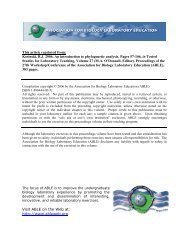Organelle Isolation and Marker Enzyme Assay - Association for ...
Organelle Isolation and Marker Enzyme Assay - Association for ...
Organelle Isolation and Marker Enzyme Assay - Association for ...
You also want an ePaper? Increase the reach of your titles
YUMPU automatically turns print PDFs into web optimized ePapers that Google loves.
136 <strong>Organelle</strong> <strong>Isolation</strong><br />
<strong>and</strong> place each into the three tubes labelled Bs, Cs, <strong>and</strong> Ds. Resuspend the pellets remaining in<br />
tubes B, C, <strong>and</strong> D in 0.9 ml of ice-cold Buffer A, <strong>and</strong> label them Bp, Cp, <strong>and</strong> Dp.<br />
7. <strong>Assay</strong> the contents of tubes A, Bs, Bp, Cs, Cp, Ds, <strong>and</strong> Dp according to the protocols <strong>for</strong>:<br />
(a) succinate dehydrogenase: use 0.5 ml/assay;<br />
(b) acid phosphatase: use 0.1 ml of 1:10 dilution (1:10 dilution prepared as follows: 0.1 ml of<br />
fractions + 0.9 ml of ice-cold Buffer A); <strong>and</strong><br />
(c) alkaline phosphodiesterase: use 0.10 ml/assay.<br />
<strong>Assay</strong> <strong>for</strong> Succinate Dehydrogenase<br />
The enzyme succinate dehydrogenase is an integral protein of the mitochondrial inner<br />
membrane. The major function of mitochondria is to generate energy (ATP) via oxidative<br />
phosphorylation. Succinate dehydrogenase, an FAD-containing enzyme, is involved in converting<br />
succinate to fumarate. In this assay, succinate is used as a substrate <strong>and</strong> nitroblue tetrazolium<br />
(NBT) as an artificial electron acceptor which changes to purple color when it accepts electrons.<br />
Thus, the <strong>for</strong>mation of purple color is directly proportional to enzyme activity.<br />
1. Label eight (8) glass tubes (13 × 100 mm) A, Bs, Bp, Cs, Cp, Ds, Dp, <strong>and</strong> BLANK. Pipet into<br />
each of these tubes:<br />
0.2 ml Buffer B [200 mM Na-Phosphate buffer, pH 7.4]<br />
0.1 ml 2.5 mg/ml NBT<br />
0.1 ml 1% Triton WR-1339<br />
0.1 ml Substrate B [100 mM Na succinate, pH > 7]<br />
2. When ready, add to each of the seven tubes (A, Bs, Bp, Cs, Cp, Ds, <strong>and</strong> Dp) 0.5 ml of the<br />
appropriate enzyme fraction. Add 0.5 ml Buffer A to the tube labelled BLANK. Note the<br />
starting time <strong>for</strong> each reaction.<br />
3. Incubate all tubes at 37°C <strong>for</strong> 30 minutes.<br />
4. Stop the reaction by adding 2.0 ml of 2% sodium dodecyl sulphate to each tube.<br />
5. Read Absorbance at 630 nm in a spectrophotometer adjusted to zero with the blank.<br />
<strong>Assay</strong> <strong>for</strong> Acid Phosphatase<br />
Acid phosphatase is present in lysosomes. The enzyme cleaves terminal phosphate groups<br />
<strong>and</strong> like other lysosomal enzymes operates maximally in acidic conditions. In this assay we will<br />
use a colorless compound, para-nitrophenol phosphate (pNPP) as the substrate <strong>for</strong> acid phosphatase.<br />
When the phosphate group of pNPP is cleaved, para-nitrophenol is generated. Para-nitrophenol is a<br />
yellow compound that is easily measured in a spectrophotometer.<br />
1. Label eight (8) glass tubes (13 × 100 mm) A, Bs, Bp, Cs, Cp, Ds, Dp, <strong>and</strong> BLANK. Pipet into<br />
each of these tubes:<br />
0.1 ml Buffer C [0.25 M glycine-HCl, pH 3.0, containing 0.5% Triton X-100]<br />
50 µl Substrate C [50 mM pNPP in water]
















